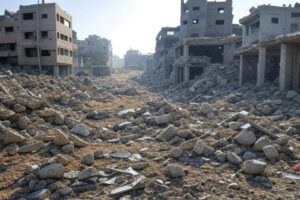
Recent rocket attacks were a stark reminder that the Israel-Gaza conflict is still here, regardless of any temporary lull in violence. The Israeli policy of restraint and appeasement has averted an all-out war, for now, but has done little to resolve the greater problem.
While some observers say that no solution exists, others have called for a radical transformation of the Israel-Gaza relationship. Below are three options for such change.
None of these alternatives is perfect. There are no guarantees or certainties. Each option promises potential rewards, but also carries some risks. Still, these divergent approaches offer a way to fundamentally reshape the Israel-Gaza conflict.
Gradual Destruction
Most experts agree that a major war in Gaza is not the optimal solution. But at least one has suggested that more small-scale wars could play in Israel’s favor. Speaking at The Institute for National Security Studies last year, former IDF general Yaakov Amidror argued that size does matter.
Israel has become much more powerful than Hamas and should consider leveraging this more directly, Amidror said. Moreover, the anti-missile defense offered by Iron Dome enables Israel to minimize the human and economic cost of military operations, he said.
More frequent wars, which would negate Israel’s traditional defense doctrine, could accelerate the degrading of Hamas military power, Amidror argued. He cautioned, however, that Israel should consider this option only if it can consistently erode Hamas’ capabilities while minimizing its own losses.
Adopting Amidror’s approach could put Israel in some tough spots, but is also likely to cause Hamas some real damage. Moreover, proven Israeli willingness to launch mini-wars could serve as an effective deterrent and reduce the terror group’s appetite for violence.
Ultimately, a weaker Hamas may be more open to rearranging the equation and mitigating the Israel-Gaza conflict. But there are no assurance of this, and no certainty that more wars will eventually bring more peace.
Economic Revolution
The notion of improving Gaza’s economic situation is not new. However, some of the boldest plans for a major facelift in the Strip have come from unexpected directions. The outspoken Naftali Bennett, normally a more militant politician with low tolerance for “leftist” ideas, is one such example.
Less than a year after Operation Protective Edge in 2014, Bennett called for a “change in policy toward Gaza” in a TV interview. Israel must initiate an international effort to reconstruct the Strip as a means of blocking Hamas’ military buildup, he said.
Another hawkish figure, Likud Minister Yisrael Katz, has more concrete ideas. Katz has tirelessly promoted an ambitious economic blueprint that includes, among other things, plans to rebuild an artificial island off the Gaza coast. So far, his program has been rebuffed.
Notably, boosting Gaza’s economy runs the risk of augmenting Hamas’ strength. However, improved economic conditions could also encourage the group to minimize its terror activities, while weakening popular support for future wars. As always, there are no assurances or guarantees.
Full Disengagement
Israel withdrew from Gaza in 2005, but still enforces restrictions on movement into and out of the Strip. Such measures exact a price on the diplomatic and public relations front. Moreover, they ensure that Israel remains at least partly responsible for Gaza’s well-being. But what if all restrictions were lifted?
Opening Gaza to the world will almost certainly provide the Strip with a major economic and morale boost. It would also free Israel of any responsibility toward Gaza, particularly if the Strip is gradually disconnected from Israel’s basic infrastructure.
However, the absence of any Israeli control would enable Hamas to import large quantities of heavy weapons in preparation for a future war. On top of this, other hostile forces would have easy access to the Strip and may offer further support. Israel could soon be facing a nightmare on its southern border.
But there is a catch. The larger and heavier Gaza’s army becomes, the more vulnerable it is to an Israeli assault. This is the classic dilemma of terror groups, as they risk an unrestrained response from a vastly more powerful state if they go too far. Another factor is Gaza’s small size, which makes military operations against it more feasible and effective.
A preemptive Israeli strike on a heavily armed Gaza would be devastating and put to waste a huge investment of resources. It could be the kind of blow that offers no opportunity for recovery. Moreover, a wealthier and freer Gaza may be at sharp odds with Hamas’ militaristic vision and put the group in a difficult domestic position.
Of course, the security risks to Israel would be great as well. But in a best-case scenario, so would the potential rewards.
In the end, none of the above alternatives promises to resolve the Israel-Gaza conflict. Each scheme also threatens to introduce new threats into the familiar equation. However, Israel’s current approach also carries risks, including some that are unpredictable. While the Gaza problem is unlikely to be resolved soon, it may be wise to start exploring new ideas.


